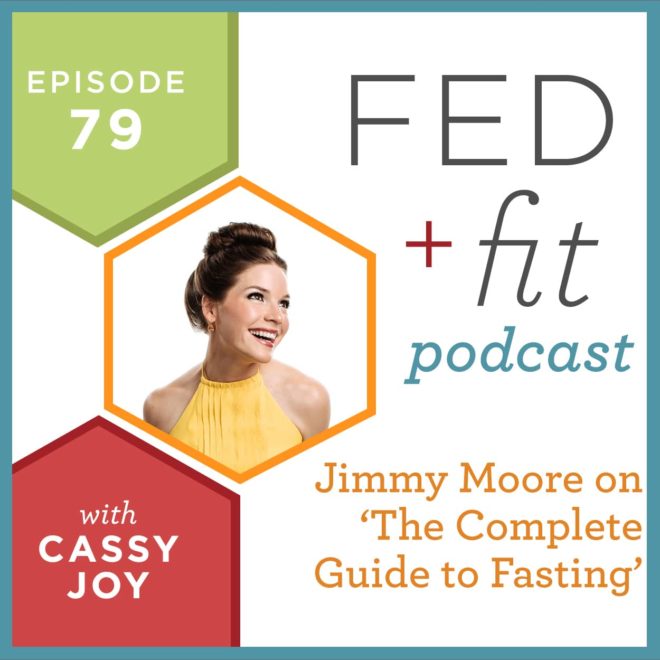Today I’m taking with Jimmy Moore, bestselling author who recently published “The Complete Guide to Fasting.” We hear about Jimmy’s health journey; some myths about intermittent, alternate day, and extended fasting; who fasting is for/who it is not for; and the potential long-term health benefits to the metabolically broken.

We’re back with our 79th episode of the Fed+Fit Podcast! Remember to check back every Monday for a new episode and be sure to subscribe on iTunes!
Find us HERE on iTunes and be sure to “subscribe.”
[powerpress]
Connect at:
Episode 79 Links
- Book 1 (most recent topic of this show): The Complete Guide to Fasting
- Book 2: The Ketogenic Cookbook
- Book 3: Keto Clarity
- Book 4: Cholesterol Clarity
- Blog: livinlavidalowcarb.com
- Podcast 1: The Livin’ La Vida Low Carb Show with Jimmy Moore
- Podcast 2: Low-Carb Conversations with Jimmy Moore, Jenna The Paleo PA and Friends
- Podcast 3: Keto Talk With Jimmy Moore & The Doc
Episode 79 Transcription
Today I’m talking to Jimmy Moore; bestselling author who recently published the Complete Guide to Fasting. We’ll hear about Jimmy’s health journey, some myths about intermittent, alternate day, and extended fasting, who fasting is for, and who it is not for, and the potential long-term health benefits to the metabolically broken.
Cassy Joy: Welcome back to the Fed and Fit podcast. Today I’m joined by a friend and I don’t know if he knows this, but I really do consider him a mentor and an example in this industry of just working with integrity, staying true to your passions. His name is Jimmy Moore, and if you haven’t heard of him before, he catapulted onto the health scene in 2004 after a phenomenal 180-pound weight loss which enabled him to come off prescription drugs for high cholesterol, high blood pressure, and respiratory problems. He is the energetic personality, that is not an exaggeration, behind the very uber popular blog, Livin’ Lavida Low Carb, and is the host of the longest running, and one of the top ranked iTunes health podcasts the Livin’ Lavida Low Carb show.
Jimmy also hosts two other active podcasts; Keto Talk with Jimmy Moore and the Doc; and Low Carb Conversations, along with the retired podcast, Ask the Low Carb experts. He has interviewed over 1100 of the world’s top health experts, and has dedicated his life to helping people get the best information possible about living health so they can make the right decisions for their health. Jimmy is the international bestselling author of the Ketogenic Cookbook, Keto Clarity, and Cholesterol Clarity, along with the October 2016 release, the Complete Guide to Fasting, which is what we are going to talk about today. Learn more about Jimmy and his work at https://www.livinlavidalowcarb.com. I am so excited to welcome you onto the show today, Jimmy, thank you so much for joining us!
Jimmy Moore: Hey Cassy! It’s fun to be on your podcast. I’ve admired your work from afar as well, so we’re definitely the mutual respect club here today. {laughs}
Cassy Joy: Oh that’s very kind of you, thank you so much! I’m excited to have you. I have been a humble guest on a couple of Jimmy’s shows before, and if you can’t tell already from his amazing voice, he’s very talented as a podcaster!
Jimmy Moore: Aww!
Cassy Joy: So, y’all are going to enjoy today’s show, I’m sure. He’s got a wealth of information, and is just nice to listen to! {laughs}
Jimmy Moore: You are very kind. I’ve done this a little while, and I’ve got a nice microphone, so those two things help. {laughs}
Cassy Joy: They do. They do help. Meanwhile I’m holding my little iTunes headphones out in front of my voice because I didn’t get my mic charged! {laughs}
Jimmy Moore: {laughs} Oops!
Cassy Joy: You know, I just like to be as honest as possible.
Jimmy Moore: “Behind the scenes of podcasting.”
Cassy Joy: Exactly; exactly. Which is really what Snapchat is all about.
Jimmy Moore: there you go.
Cassy Joy: Are you on Snapchat yet?
Jimmy Moore: I do have Snapchat. I’m not very good. I do Periscope and literally everything else but Snapchat. You’re the millennial generation; I’m gen X, so we’re a little bit harder to get to that Snapchat thing. {laughs}
Cassy Joy: I totally understand. I definitely understand. And if you guys are on Periscope and you don’t already follow Jimmy, you should definitely look him up. He is the Periscoper, in my mind. So, that’s awesome! Well I’m excited to have you on today. I have; gosh, I’m in the 80s now with this episode. We’ve been doing it a little over; going on 2 years. And I have never had a guest on that could speak so well to this topic, and people are just starved for this information.
Jimmy Moore: Literally.
Cassy Joy: {laughs} Literally! Badum-psh!
Jimmy Moore: {laughing}
Cassy Joy: So I’d love to talk about the Complete Guide to Fasting, your most recent book, which is hitting shelves. It’s Heal Your Body Through Intermittent, Alternate Day, and Extended Fasting. You co-authored with Dr. Jason Fung.
Jimmy Moore: Yep.
Cassy Joy: And I would love if you could just give folks a little bit about what the book is in a nutshell and really what you were aiming to solve by getting this out into the world.
Jimmy Moore: The main thing we were trying to solve, Cassy, was there was no resource out there for people that were interested in doing any kind of fasting. I mean, you brought up fasting and people said; “Just don’t eat.”
Cassy Joy: {laughs}
Jimmy Moore: There’s fasting. No, it’s a little more than that. {laughs} That’s definitely the starting point, but there’s more to it than that and up to this point the only people that had written books about it were basically body builders who used intermittent fasting within their routine. So there were no good resources. Dr. Fung, as you mentioned, my co-author, he actually runs an intensive dietary management program in Toronto, Ontario, Canada, and has put well over 1000 patients on some form of a fast, be it intermittent to very long fast, which we’ll talk about.
So the resource wasn’t out there, and I actually met Jason in South Africa, of all places. I had to go halfway around the world to meet this guy, and he’s just up the road from me in Canada. So I said, dude, I want to do more of these kind of fasting type of things, is there a resource that you could recommend to me? And he said, you know, there’s really nothing. So I said, well I’ve got a good publisher, I’m very interested in this subject, you want to collaborate on a book? And he’s like, ok, sure. {laughs}
Cassy Joy: {laughs}
Jimmy Moore: I cajoled him in. So we wanted to make this not just a how-to, which the how-to is important, just don’t is definitely the first point. But we also wanted to give the background. We wanted to give kind of the metabolic things that are going on as to why you need to fast, and who needs to fast, who doesn’t need to fast, and all those myths that are out there about fasting. We wanted to bust all of those things. We wanted to provide, basically, a lot of hand-holding and then back it up with science. At the end of each chapter, we actually have a long list of scientific references for those of you who geek out on that kind of thing. But if you just want to learn, “here’s how you do it,” we definitely give a lot of that, as well. And people that are familiar with my Clarity series; Keto Clarity and Cholesterol Clarity, and how user friendly and consumer friendly the language is, we definitely tried to keep it in that same vein with this book. We literally wanted it to be the go-to resource if you wanted to learn about fasting.
Cassy Joy: That’s fabulous. And I have flipped through the book; and just to your point, it is very conversational, very informative, and honestly it’s answered almost every question I could think about fasting. So you really nailed it. It really is a concise handy resource and it’s a question I get a lot; “What do you think about intermittent fasting? It’s something I’ve heard about.” And this tells you, like you said, the beginning, the middle, and the end. All of the research, the things you want to know, who it is for, who it isn’t for, and the difference between intermittent and other versions of fasting. So that’s fabulous.
What do you think are some of the biggest misconceptions about fasting, especially in this paleo world? Because it kind of seems to be; you know, folks tend to, when they think about paleo or they jump into paleo, they’re trying to break out of that diet cycle, and it seems once they’ve broken out of that and they’ve healed their bodies, it’s hard to break out of the need to want to jump into another diet and another program. And it often seems; and fasting, I think is a really powerful, incredibly positive tool for some folks. But there are some misconceptions about what it does and what it doesn’t do. So can you kind of maybe daylight a couple of those misconceptions? Of course you can look into the book for the full list.
Jimmy Moore: {laughs} Absolutely. And I’ll give credit to the paleo community, because I kind of joined in around 2011 when the first Ancestral Health Symposium came around and I had already interviewed Robb Wolf and Mark Sisson and different ones in the community. I give them credit, because but for that nudging from the paleo community to take a closer look at fasting, I might not even be talking about it here today in 2016.
Cassy Joy: Mm-hmm.
Jimmy Moore: So kudos to paleo and the leaders there in kind of putting this on my radar screen. The biggest fears I think that people have, Cassy, it boils down to two main ones. Number one, people think that you’ll go into some sort of starvation mode if you start fasting; and the second one is you’re going to lose muscle when you fast. So those are probably the top two kinds of fears that people have about fasting as to why they don’t want to do it.
So the starvation mode one is an interesting one, and we go very deep in the book on this particular topic, because it’s interesting and counterintuitive that when you totally, totally fast and don’t eat any food at all your metabolism does not slow down so you get lethargic. Oh, by the way, full disclosure; I’m in day 11 of no food. I have not eaten in 11 days doing this interview right now.
Cassy Joy: Oh my goodness.
Jimmy Moore: So I’m living what I’m saying here. So when you don’t eat any food at all, you actually see your metabolism rev up by at least 12%. Now, that goes against everything everybody has ever told you about fasting, and a lot of the negativity that’s out there about fasting, even from the so-called people touting science, is they’re looking at starvation studies.
Cassy Joy: Mm-hmm.
Jimmy Moore: Starvation and fasting are not the same. Starvation is where you’re forced to not eat. You’re not able to be in control, you just aren’t allowed to eat; at all. Fasting on the other hand puts control; that’s the word I want you to remember; you have full control when you are fasting. If you’re in the midst of a fast and if at any point you start to feel ill; guess what? You can end that fast within 3 seconds by going to your refrigerator.
Cassy Joy: Uh-huh.
Jimmy Moore: And that’s the big key here. So you’re not in any starvation mode. You’re in a purposeful state to not eat for a period of time, and the reason that I’m doing it, and you know me well; I have pretty bad insulin resistance from poor nutritional choices of the past that make me struggle. And so quite frankly, it’s a lifesaver to be able to add fasting into that kind of therapeutic protocol for Jimmy Moore, and it’s helping. It’s helping little by little.
So that’s the first one people have; starvation mode. You’re not starving. What’s happening is, your body ends up using and tapping into that source of energy that’s on your body; especially if you have extra belly fat, you’re going to have plenty of energy on your body. Which is why when you start fasting, you see blood ketone levels, for example, go way up. This morning on day 11 of this fast that I’m on, I was at 5.4, which indicates that there’s quite a bit of fat burning going on within a fast. And you would expect that. I mean, you don’t eat, Cassy, you’re going to lose weight, right? So that’s a, “Well, duh.”
And a lot of people say; “Well, you’ll just gain all of it back when you start eating.” Yes, you gain some back, but what we say in the book is, you should plan on, for every day that you fast, you’re going to lose about a half a pound of body fat. So anything above and beyond that means that you have some extra water, you actually are very insulin resistant and by the way, what did I say, day 11 I’m on now, I’ve lost 23 pounds in 11 days. So that tells you just how bad the insulin resistance is me.
Cassy Joy: Holy… Mm-hmm. Wow.
Jimmy Moore: So that’s the first one. And then the other is loss of muscle; and actually just the opposite, once again, is true. What we see is the production of the ketones actually helps to preserve muscle mass. So you’re not losing gobs, and gobs, and gobs of muscle, especially when you have plenty of fat on your body. All those starvation studies that are noted; those guys, they basically starved them down so they had no more body fat to really tap into, so their bodies had to tap into protein as an energy source. But the body doesn’t just automatically store all that body fat on your body and then when it comes time to be used, tap into the muscle? That doesn’t make sense. It’s going to prefer the fat first, and if you’ve got obesity, you definitely have fat to burn.
Cassy Joy: Interesting. So metabolically, the body will prefer fat. Muscle will be one of the last…
Jimmy Moore: All day, every day.
Cassy Joy: Love it. Awesome information! So you’re working through an extended fast right now, is that right?
Jimmy Moore: Yes, I am pursing 21 days, yes.
Cassy Joy: Wow, that’s so cool! That’s so fascinating. So I’m curious now; in an extended fast, are there any precautionary measures you need to take in terms of exerting yourself. Do you live your normal life? Do you then go and work out, for example on your normal schedule, or do you dial some activities back? Do you sleep more or less? What are those kinds of considerations?
Jimmy Moore: What great questions. So, one of the things that we say very clearly in the Complete Guide to Fasting is, just live your life. Now obviously, if you’re a hardcore crossfitter, and I know probably a lot of your listeners do like Crossfit, you might want to back off on glycolytically demanding type of exercise if you’re doing this long of a fast. But keep in mind, most of these fasts are for people that are severely metabolically broken. So doing this long of a fast probably isn’t a good idea. For a crossfitter, maybe you intermittent fast, and a lot of them do. Maybe you even push it to 48 or 72 hours, and you do your Crossfit in that fasted state. You actually can improve your metabolism even more when you do that, and this is kind of a secret with a lot of body builders. They use this strategy of basically working out in a fasted state. Shh, you’re not supposed to let anybody know that. But that’s what they do, and it just has so many great downline metabolic effects.
Now, for the average Joe like myself, doing these longer fasts obviously you don’t want to do anything really glycolytically demanding; I’ve actually tried that in the midst of a fast, and you might pass out, so be careful! {laughs}
Cassy Joy: Oh my! Mm-hmm.
Jimmy Moore: But I think you can do your day-to-day stuff, you can do some pretty good cardio when you’re this deep into a fast. And I do fine. And as you can tell from my energy right now, I am not at all tired, I’m not at all lethargic. You will be full of energy. You’ll have moments; I won’t lie. You will have moments here and there, and we talk about how to deal with those waves of hunger that come and just kind of the feeling. Like I was at church last night and was singing in the choir, and we stood up for a little while, maybe like an hour, and I started to get a little bit woozy there. But that’s not; I think more of it had to do with the time of night. My circadian rhythm is just so spot on that when that sun goes down, I get sleepy.
Cassy Joy: {laughs}
Jimmy Moore: So, combine the two and I was about ready to go to sleep. So I got home and I did go to sleep. So those are the things that people worry about, but it’s not really something to be concerned about.
Cassy Joy: That’s fascinating. Ok, so in, again, the context of an extended fast, correct me if I’m wrong but you’re not just drinking water all day. You do consume some things other than water, is that correct?
Jimmy Moore: So we do allow, in the book, if you want to and need to have something else besides water, we do talk about tea and coffee. Green tea, especially; Dr. Fung is a big fan of the green tea during the fast. What we’re not talking about is bulletproof coffee {laughs} during a fast. I mean, unless you absolutely must, must, must have something like that, the problem with bulletproof coffee and other types of things like that is it’s just very high in calories. And the point is, you’re trying to keep the calories very low.
Now, I know my friend, Dave Asprey, would say, “Well, if you just drank a bulletproof coffee in the morning that 800-calorie cup of coffee will keep you in a fasted state.” Well, with all due respect, no. it does not keep you in a fasted state, not in the truest sense. Will it keep insulin down? It should, but I think if you want to be true to the fast then you need to not have too many calories.
The experiments that I’ve had, Cassy, have been well under 200 calories, and I would even say most days under 100 calories. On my past fasts, I’ve had bone broth with sea salt for example. Some people find that that gives them an effect of having a meal, it’s almost like chicken noodle soup. I love chicken bone broth!
Cassy Joy: {laughs}
Jimmy Moore: So I’ll do that, and I’ve also had kombucha during previous fasts, as well. This current fast I decided I wanted to try it mostly water, so I’ve been doing water all but one of the days; I had bone broth on day 5 because I started to not feel well, so I had a little bone broth and within seconds of drinking that bone broth with the sea salt I felt better instantly. So that’s all I’ve had on this 11 days. And it’s a thing that you’re going to build up to. And this is one thing I want to make sure we communicate very clearly; don’t hear me say, “Jump right into a 21-day fast!”
Cassy Joy: Mm-hmm.
Jimmy Moore: That would be stupid. {laughs}
Cassy Joy: {laughs}
Jimmy Moore: Start slow. If you’ve never fasted before, first I would say, you know, you might want to consider maybe upping your fat and lowering your carbohydrate in your diet and try to get into more of a fat burning state. Don’t jump from a Standard American Diet; or even a high carb paleo diet into fasting and think that you’re going to do well. You’re going to be miserable probably the first couple of days if you do that. Whereas if you shift to that higher fat and lower carb, get used to basically burning fat for fuel in a fed state; when you start fasting you’ll find, “Oh, well my body knows how to use fat for fuel very well” and it just kicks in a lot faster with less pain, I guess is the word.
And so, then if you’ve never cut out a meal, cut out one meal a day. Maybe cut out your lunch meal and just eat breakfast and dinner. And from there, maybe try fasting for 24 hours. And then build your way up to 36 hours. And if need be, go to 42 hours, 48 hours, and then some of these longer ones. You don’t just dive right into it. Think of it as learning how to ride a bicycle. You weren’t good when you first started, but now you build it up and you get better and the better you are the funner it is, too. {laughs}
Cassy Joy: Yeah, that’s great. And I think it’s important, too. You have given a lot of considerations, you and Dr. Fung, in this book. If someone listening is thinking that they do eventually want to work up to a really long, extended fast, whether it’s 21 days or somewhere around there; read the book. Get the book, read it, understand the literature, understand the whys, and maybe some things to look for in your own body to know if you’re on the right path, and then go for it. So I think that’s wonderful; stay as informed as possible.
Jimmy Moore: Oh yeah, that’s my theme song. It’s like, an educated patient is one that cares about their health and doesn’t feel like they have to necessarily go to the doctor for every little thing. And quite frankly, doctors can learn from you. And I think sometimes we lose that in the white coat syndrome; we just think they have all the answers. But they’re learning just as much as you are, so if you learn something profound and find that fasting is helping you in some way, you’re going to educate them.
Cassy Joy: Mm-hmm. That’s fascinating. You know, it’s funny, it’s turning into kind of a central theme in this podcast, and I tend to believe there’s a reason for that. There’s a group of listeners who need to hear that information; because it was mentioned on the last episode, as well. By Mickey Trescott, so I definitely remember that.
Jimmy Moore: Oh, I love Mickey.
Cassy Joy: She’s great. She’s really great. Ok, another question I have for you; can you explain to us just briefly the difference between; we’ve talked about extended fasting, but intermittent and alternate day, what are some of the major distinctions there.
Jimmy Moore: Yeah, so an intermittent fast; think about it this way, you guys. You eat dinner at 6 o’clock at night; you wake up the next morning, you eat breakfast at 8 o’clock in the morning. Guess what; you’ve intermittent fasted, because that’s 14 hours where you went without food. Now, that seems obvious, you’re going to sleep and you’re going to have periods of time between eating, and that’s why the first meal of the day they call the break-fast. Did you ever stop to think about that’s where that came from? It’s the first meal of the day that would basically break your overnight fast.
So what we’re talking about with intermittent fasting is, maybe skip that first meal of the day and push your break-fast to the middle of the day. So what we generally would call lunch now becomes your breakfast. I’ve said this with Keto Clarity when I was doing interviews for that; I believe breakfast is the most important meal of the day. They keep telling us that; breakfast is the most important meal of the day. I just don’t think it has to be at 7 a.m. or 8 a.m.
Cassy Joy: Right.
Jimmy Moore: You can have it at 1 o’clock in the afternoon. That’s your break-fast. And so, we’ve got to get out of this cultural meal time paradigm. I think sometimes we just kind of get caught; well, it’s 8 o’clock, I’m supposed to be eating something. Oh, it’s noon, I’m on my lunch break, so I should be eating lunch. No, you really don’t have to eat by those patterns of the clock. Eat basically by the hunger signals. So if you wake up in the morning and you’re not hungry, guess what? Skip that meal and then eat when you do get hungry, which will probably be around the time of your lunch time. So if you push it from 6 o’clock the night before to about noon the next day, that’s a pretty good little intermittent fast, and what you’re doing is you’re giving your body a chance to have a break.
You think about the dieticians and what they tell patients to do to manage their blood sugar and keep their metabolism going; they say, “You’ve got to eat every 2 to 3 hours.” So we’ve heard that again and again, and we think if we ever go periods without eating, we’re going to go bonkers. So what amuses me, Cassy, is when you hear these stories of people that are on airplanes that get stuck on the tarmac; “Oh no, what are we going to do?” And it’s been like 2 hours since they last ate, and yet they’re freaking out because they can’t have any food to eat. {laughs}
All of these kind of images that we have about it, we’ve just got to drop that. I think the mysteriousness of it needs to go away. This is a completely normal, and especially if you’re eating a very micronutrient dense and appropriate macronutrient type of diet for you, intermittent fasting should come extremely naturally. That’s one thing I found when I went ketogenic for me, was that I found that I would spontaneously intermittent fast upwards of 18 and 24 hours between meals, and didn’t even think about it. And I think that’s such a foreign concept, again, because we’ve been taught, “Eat every few hours.” I think we’ve become such a feasting society that we forgot about the ancient art of fasting.
Cassy Joy: That’s wonderful. I love it! You know, in the Fed and Fit Project I actually recommend no snacking for a lot of the same; the same logical reasons, the background information that you’re talking about here. Because I really do believe our bodies are meant to have a break in between meals.
Jimmy Moore: Yep.
Cassy Joy: Absolutely. Well more power to you; that’s wonderful. It’s a question I get a lot, because intermittent fasting is; you know, it’s a wildfire right now and people are really, really intrigued by it. And we’ll get to alternate day in just a second, but in the book you do a really thorough job of describing who fasting is for and who it is not for. There are some listeners who I know are trying to build body mass; build muscle mass. Would you say that fasting is right for somebody like that? Because there are some folks who I know they can identify themselves as; maybe not metabolically broken, but they know something; they could stand to make some changes, to heal themselves in certain ways, but if someone is really looking to build, is intermittent fasting a good solution?
Jimmy Moore: Like I said early, the bodybuilders, they’ve been using this for years. They know the power of intermittent fasting and ketogenic diets, specifically for building muscle. And what’s interesting is, you often hear them say; “Well you can’t both burn body fat and build muscle at the same time.” Oh yeah? Yeah you can. {laughs}
Cassy Joy: {laughs}
Jimmy Moore: So yeah, this is a very effective strategy for that. But you asked who can’t fast, and I want to make this very clear. If you are a child under 18, do not fast. You’re still growing, you don’t need to be fasting, and this could inhibit some of that if you do fast under 18. Number two, obviously, anybody that’s underweight. Because when you go on a fast, you’re going to lose weight. Surprise, surprise! You’re going to lose weight. So if you’re underweight, if you’re a 23-year-old, 90-pounder, don’t fast. No. No. And then the last one is, if you’re pregnant. Again, obviously, if you’re pregnant, you’re trying to nourish that little one that’s inside of you and it’s just not an appropriate time to fast.
Other than those three categories of people I just described, basically anyone could apply some principle of fasting into their life, be it intermittent fast, alternate day fast, or some of these extended fasts.
Cassy Joy: Fascinating! Man, really cool stuff! This makes; honestly, I don’t know about the listeners, but it makes me want to look into one! That’s fabulous. So can you tell us a little bit more about your partnership with Dr. Fung? Where is his practice, and how did you guys team up to really write this book together?
Jimmy Moore: Oh, this is a fun story, Cassy, because I had never heard of him before and I was invited to come speak at a big low-carb conference that took place in South Africa in early 2015, and Jason Fung was one of the speakers ,as well. So we shared a stage together, and I’m sitting there watching him give his talk all about fasting; and of course, I’d been on and off intrigue about fasting over the years. I definitely do a whole chapter about the “F” word, as I call it, in the book {laughs}. So he gives this talk about fasting; and I’m going, wow that is very “fastinating.” Sorry, that was a pun.
Cassy Joy: {laughing}
Jimmy Moore: And so I went up to him afterwards, and I said, “Hey, this is incredible information.” He’s a nephrologist in Toronto, Ontario, Canada. So I said, “Are there any good resources for learning how to fast, and do it well?” “No, not really, other than the bodybuilders, Brad Pilon Eat Stop Eat is a pretty good one,” he said, and I had read that one and actually had him on my podcast. And other than that, he said no not really anything. And I said, “Well, why don’t we write one together?”
So I said, if I’m going to write a book with this man who has put over 1000 patients on some kind of fasting protocol, maybe I should try some of these longer ones for myself. So we collaborated, started to write the book, and I started doing my longer fasts, and last September, September 2015, I actually did a 17-1/2 day in a row fast with bone broth, water, and kombucha. And that was kind of my protocol; and I only made it 17-1/2 days. My goal was 21, just like it is right now with what I’m doing right now. But 17-1/2 days, and it was foiled by stress.
So when stress hit; and this is a big point I want people to know; there are factors that will increase your blood glucose, even during a fast. There are factors that will make you actually gain weight during a fast. I gained 3 pounds in the last couple of days in that 17-1/2-day fast because of the stress. So the stress response; don’t ignore it. I knew I had to end it before the 21 days because I was starting to get the hunger signals coming on really strong, again, because of the stress. Dr. Fung was kind of educating me all along the day. “Oh yeah, I could have told you that was going to happen.”
Cassy Joy: {laughs}
Jimmy Moore: I said, “We need this book out there sooner than later!” So I’m glad it’s finally out there as a resource. Right as I’m learning and getting pretty good at this fasting thing. {laughs}
Cassy Joy: That’s wonderful. Isn’t that funny. Well, it falls into your hands right when you need it.
Jimmy Moore: There you go.
Cassy Joy: That’s fabulous, Jimmy! Well thank you so much, this has been so educational, and I’m sure that it’s resonated with a lot of listeners here. Is there anything else you’d like to mention before we tie the show up?
Jimmy Moore: Yeah, I just think if you’re listening to this and you go, “Man, oh man, that all sounds interesting but I could never go without food.” Let me give you a practical progression of fasting. If you’ve never even thought about fasting before, do it this way. Start off by eating a nutrient-dense, paleo style diet if you’re not already doing that. Most of you listening to Cassy probably are. Then, from there maybe try upping your fat and lowering your carbs a little bit, because you want to start letting your body get used to running on fat for fuel. Then once you get there, you’ll probably get to this next step spontaneously; try cutting out all of your snacks. Of course, if you’re listening to Cassy you’ve probably already done that; and if you haven’t, do it. And then cut out one meal a day, and then from there try to eat within a 4-8 hour window.
And then once you’ve mastered that, then go to alternate day fasting, which we didn’t talk about, but basically it’s eat Monday, don’t eat Tuesday, eat Wednesday, don’t eat Thursday. It turns out to be about a 36-hour fast when you do it that way. And then once you nail alternate day fasting, then try an extended fast. Don’t just go 48 hours because day 2 is the sucky day. You get past day 2, and it’s nirvana after that. So definitely try to do at least 3 days if you’re going to do an extended fast. And then if you nail that and you feel like you need to go longer to keep getting the results that you’re looking for, try a week. Once you get a week, then try a little bit longer. Most people, Cassy, will probably get most of the benefits of fasting long before these extended fasts. The extended fasts are for the truly broken, metabolically ill people. People that used to weigh 410 pounds in their life.
Cassy Joy: {laughs}
Jimmy Moore: “Jimmy Moore!” So you may not need to go that long to get all these benefits that we’re talking about.
Cassy Joy: Wow. That’s wonderful. Awesome information; I’m so glad that you guys got to hear it directly from Jimmy. He’s a wealth of information, and he really does his research. Thank you so much for coming on the show today.
Jimmy Moore: Thank you Cassy!
Cassy Joy: Oh my goodness, it’s been such a pleasure. Remember that you can find Jimmy online at https://www.livinlavidalowcarb.com. I’m sure he’s got links to all of his podcasts on his website.
Jimmy Moore: Yep.
Cassy Joy: And you can find those there, and then you can also grab the book; the beautiful book sitting in front of me. The Complete Guide to Fasting; Heal Your Body through Intermittent, Alternate Day, and Extended Fasting. Co-authored with Dr. Jason Fung. Thank you again so much for joining me today. I will provide links to all of this on the website so you can go ahead and go straight to https://fedandfit.com and click to grab the book, and click to go to his website. And if you miss something, or if you want to reread something that we talked about today, remember that you can pull up the full transcript for today’s show and get the information that way. Thanks again for joining us; we’ll be back again next week.












I don’t know what to think after listening to this podcast, while I don’t think I need to eat 5 times a day like it is commonly recommended I don’t know about not eating for days. Like Ashley I would like to hear if you are considering a fast?
Very interesting! So I’ve got to ask you Cassy, are you considering trying one of these fasts? If so, which one?